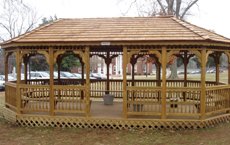In an effort to have less smoking on campus, Guilford has again revised the new smoking policy for the 2004-2005 school year. Campus Life is now working on changing the designated areas for the dorms, the last areas to have non-smoking entrances. The policy, which was introduced in fall of 2001 and has changed since last fall, began with smoke-free dorms and has progressed each semester with more smoke-free areas.
Campus Life felt it was important to clear the air from the main entrances of buildings and most public areas on campus.
Administration has progressed slowly to eliminate smoking, so as to not rush the policy and let the student body know of the changes along the way.
“I think it’s hard for people to get used to, but it’s more of a public health danger” said Anne Lundquist, Dean of Campus Life.
Guilford has a higher population of smokers than non-smokers.
Guilford’s goal is not to be smoke-free, but rather a more air-friendly and safer environment in which to live. For the most part the changes are made, but there are still some questions and unfinished regulations regarding the policy.
“We did decide to allow Residence Life to work with students this spring to determine which entrances to Resident Hall Buildings would be smoking (or) smoke-free” said Lundquist via-email. “That is happening now and will go into place once settled.”
Concerned about the safety and health issues for all students living in the dorms, Lundquist said there could and would be problems if a cigarette is left unattended in a dorm room, or if non-smokers are breathing second-hand smoke.
The two past surveys about cigarette smoking on campus helped administration figure out how and where the designated and non-smoking areas were to be.
These surveys asked questions about smoking areas, issues, preferences, suggestions, etc., and spawned a few community forums that discussed the issue.
The forums helped Campus Life implement the smoking gazebos and place urns where they were needed for the smokers.
“Having a designated space is helpful, like the gazebos,” Lundquist said.
Assistant Professor of Foreign Languages and Division Director Hiroko Hirakawa said via e-mail, “As a smoker, I think it’s good because I don’t have to feel guilty about ‘contaminating’ the air for non-smokers as much as I used to.”
And for those who are trying to quit, having less places to smoke could possibly decrease the amount in which they do.
“It forces me to go outside – smoking in the rain, snow, etc. – which helps me smoke less,” said Hiroko.
Although the policy has taken four years to become publicly acknowledged, there are students who are still unsure as to where the smoking areas are on campus, besides the gazebos.
There are no-smoking signs where there are ashtrays and smoking urns, including the front entrances of some buildings on campus such as Duke hall and Hege library.
“I think it’s conflicting that they have ashtrays where they have no smoking signs,” said senior Josh West. “(Campus Life) is trying to be clear. I see where there are signs, but it’s just a time of adjustment.”
The student handbook states that the college-owned houses are designated smoke-free. But if all the house members agree to a smoking environment, there can be a contract agreement signed to designate the house(s) smoking.
Campus Life wants to transition the community to all non-smoking entrances of the interior campus.
And while that process is still continuing currently, Lundquist wants the community to know that “People are not supposed to smoke on the brick walkways. That was one of the clarifications from fall to spring.”
The smoking policy is still new, and the administration is doing what it can to spread the word across campus.
There are, however, more concerns and suggestions from the student body.
For senior Susan Rhamsdorff, the smoking areas now outside Dana auditorium are not the best places for Guilford to designate. “Right now they’re underneath the practice rooms and in front of the chorus room.”
Directly affecting lesson and class times, the smoking area on the side of Dana are a potential problem for vocalists and musicians, but Dana is not the only area that has student’s concerned.
“I thought it was unfair to take smoking away from the Underground. The smokers need a place to go that’s inside,” said Rhamsdorff.
“I still think there should be ashtrays on top of the trash cans.” West said. “Smokers can avoid setting trash cans on fire.”
Trying to work with the needs of smokers and non-smokers, Campus Life wants to have a cleaner, safer environment.
“I think the advantage is you can walk on campus, go in and out of buildings, and not come into smoke,” said Lundquist.
“It’s a community policy,” she said.

